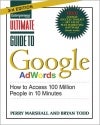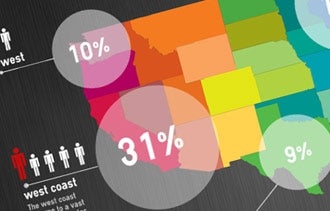How to Mine Google's Gold Mine for Local Businesses
In their book, The Ultimate Guide to Google AdWords, 3rd Edition,
authors Perry Marshall and Bryan Todd lay out the fundamentals of
Google's pay-per-click advertising system and detail how businesses can
build campaigns to increase search engine visibility, capture clicks and
increase sales. In this edited excerpt, Marshall and Todd discuss how
Google AdWords and Place Pages can be a gold mine for local businesses.
Related
- Forget the Phone Book. How to Generate Leads for Local Businesses
 Ultimate Guide to Google AdWords, 3rd Editio
Ultimate Guide to Google AdWords, 3rd Editio
Ninety-seven percent of consumers use the Internet to
research local products and services. Most brick-and-mortar businesses
don't realize the opportunity available to them for free by combining
the power of local search marketing and online reviews.
Google has processed so many searches that it has an excellent idea
of how people make buying decisions and where an individual searcher is
in the buying process. It can figure out whether a searcher is likely
looking for information or to buy something locally.
With just a few pieces of information and a little bit of work, your
local business can compete with the large corporations for targeted
customers. You can also dominate your in-town competition and gather the
lion's share of local customers.
A few years ago, Google started dedicating a portion of search
results to local businesses, and people have using Google like a phone
book. In 2011, approximately 25 percent of all searches on Google had
local intent, and that number is growing dramatically as more people buy
smartphones with Internet access.
Based on a searcher's IP address, Google knows your geographic
location, so it can easily provide local solutions to your query.
Looking for a Chinese restaurant, mountain bike or a plumber? Your first
page results will show you the businesses nearest you that may have
what you're searching for.
This is great news because now your local business is only competing
against immediate local competitors for these searches. When the search
is clearly of local intent, you no longer have to worry about national
companies hogging the first page of the search results. All you have to
do is know how to get on the first page.
Google's response to all of the searches with local intent was to
create what's called a "Place Page." Chances are Google has already
given you one. You just have to optimize it to turn it into a Google
goldmine.
Most Place Pages are automatically generated based on information
Google finds from multiple sources across the Internet. Every local
business needs to find and claim its Google Place Page and make sure all
the information is correct and up-to-date.
If you are unable to find your Google Place Page, you can create one
if your local business meets Google's guidelines for local search. Then
you need to integrate your Place Page with your website and optimize it
to rank highly for local search.
Your Place Page contains all sorts of information designed to help
the searcher choose you over other businesses. You can list details like
hours, directions, payment accepted, etc., and add photos, videos and
coupons.
A steady stream of customer reviews is crucial to optimizing your
Place Page to appear on page one. People make choices based on the
recommendations of others; studies show that as many as 70 percent of us
will trust what a perfect stranger says about a company.
Marketing experts cite the importance of word-of-mouth marketing and
referrals, and a review is permanent word-of-mouth. A review on Google
has maximum value because it's available to searchers when they're
closest to the end of the purchasing decision. They are using it to
affirm their decision.
Once you start getting reviews on your Google Place Page, you will
start earning star ratings. Ideally, you want a five-star rating with
consistent fresh reviews. Five stars are natural click-magnets, and
Google now shows your five-star rating within your AdWords listing.
Having the five-star rating as part of your AdWords campaign can
increase your click-through rate substantially, give your marketing
campaign greater impact and reduce your cost-per-click.
Star ratings can fluctuate depending on how many reviews you have,
how fresh they are, how positive they are and how well your competitors
are keeping up with you.
Just because you have five stars now doesn't mean you'll keep them
forever. So you need to integrate some sort of system into your daily
operations that will generate consistent reviews from your customers.
It also means you should monitor the reviews on your Place Pages on a
weekly basis. Just one negative review can mean an 80 percent drop in
new business you might otherwise receive from local search. Anyone can
say anything about your business on the Internet and get away with it,
so customer service and conflict resolution are more important than
ever.
If you receive a negative review online, it's almost impossible to
get it removed. The best thing you can do to minimize its effects is to
have a constant flow of fresh good reviews. For most businesses, this
means that the most recent review should never be more than seven days
old.
If you're using Google AdWords, a properly optimized Google Place
Page and a process for collecting ongoing fresh five-star reviews, you
will have created an online marketing weapon -- an effective way to
boost your business with Google local search.
Related: Building a Successful Google Campaign from Scratch
 This article is an excerpt from The Ultimate Guide to Google AdWords, 3rd Edition available from Entrepreneur Press.
This article is an excerpt from The Ultimate Guide to Google AdWords, 3rd Edition available from Entrepreneur Press.



















